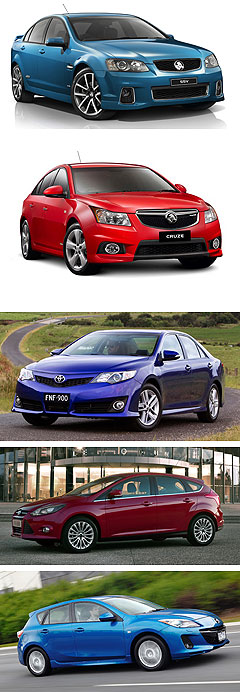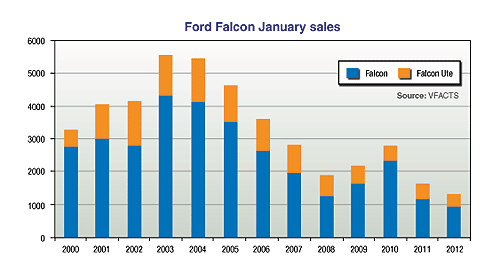News - Market Insight - Market Insight 2012Market Insight: Falcon sales crash to all-time lowSlumped: Just 931 Ford Falcons were sold in January - the lowest result in the nameplate's 51-year history. Ford Falcon registrations hit record low in January as Commodore sales also slide2 Feb 2012 UPDATED: 7/02/2012FORD Falcon sales crashed to just 931 in January – the lowest monthly sales tally in the nameplate’s 51-year history and the first time on record they have failed to reach the 1000 mark. Sales of Australia’s top-selling large car, Holden’s Commodore, also slumped badly last month, when just 2170 were sold – down from 2645 during the same month last year. Coincidentally, Holden announced last Thursday that it will cut up to 200 jobs and scale back production capacity at its Adelaide production line from 460 cars per day to 400 by cutting back to one shift instead of two on the general assembly line. Holden’s bad news came just over a week after Toyota Australia announced it would axe 350 jobs at its Melbourne plant to meet slower demand. Ford slashed 240 jobs in mid-2011 due to weak sales. Official VFACTS figures for January released last Friday confirmed preliminary figures obtained by GoAuto earlier the week that Ford sales slumped by 9.0 per cent last month. Toyota sales were down 5.1 per cent and a number of brands fared even worse, including Honda (down 29.1 per cent), Suzuki, (down 21.0 per cent), Peugeot (down 10.5 per cent) and Subaru (down 9.2 per cent). Holden was among the majority of mainstream brands to post a sales increase – up 8.1 per cent – while Kia raced to a 24.4 per cent sales spike and other full-line importers like Mazda (up 17.8 per cent), Nissan (up 9.9 per cent), Hyundai (up 1.6 per cent) and Mitsubishi (up 0.6 per cent) were also up.  From top: Holden Commodore and Cruze, Toyota Camry, Ford Focus and Mazda3. From top: Holden Commodore and Cruze, Toyota Camry, Ford Focus and Mazda3.Toyota again topped the sales charts with 14,065 registrations, followed by Holden (9061), which was narrowly ahead of Mazda (8479), while Hyundai sold 6513 sales to out-pace Ford (5838) – less than 500 sales ahead of Nissan (5358). However, just as the homegrown Falcon was again outsold by Ford’s imported small car, the Focus, Commodore sales were eclipsed by a Holden small car – the Cruze – for the first time in the large car’s 34-year history. Aided by the addition of hatch to sedan sales from December, the Cruze found 2445 homes last month, alongside 1318 Barina light car sales, plus 1659 Captiva SUVs and 673 Colorado utilities. The car that last year dethroned the Commodore from its 15-year reign as Australia’s most popular car, the Mazda3, was the nation’s top-selling car again in January with a massive 4045 sales, putting it comfortably ahead of Toyota’s former small car champ, the Corolla (3383). Combined with just 473 Commodore Utes and only 96 Caprices, Holden sold just 5184 locally produced vehicles last month. Ford fared far worse, however, with just 931 Falcon sales combining with a lowly 394 Utes and only 804 Territorys to total just 2129 sales of Broadmeadows-built vehicles last month. Ford said Falcon sales were heavily impacted by hail damage to cars waiting to be trucked from the factory to dealers in December, and January is a traditionally slow month for vehicle sales – especially to fleet buyers that account for the vast majority of Australian-made vehicle demand. To run insult to injury, while Focus sales soared to 1576, sales of Ford’s other imported models slumped in January, including the Fiesta (888), Mondeo (364) and its own new locally engineered, Thai-built Ranger, which with just 618 sales was outgunned even by Holden’s aged Colorado, which is in run-out ahead of the redesigned model’s debut around June. Of course, the problem for Ford is that the new Focus is not produced in Australia, as it was to have been before the Blue Oval backflipped on a plan that would have seen both it and Holden produce their small cars locally. The January sales slump keeps the spotlight on its local manufacturing operations, which are guaranteed only until 2016 following the recent announcement of a $103 million investment, including $34m from the federal government. However, Ford is confident the interrupted rollout of the FG MkII Falcon, which was to have hit dealers in late December, and the first four-cylinder Falcon – the turbocharged EcoBoost model, details of which were announced yesterday – will boost Falcon sales from April. Ford Australia had one of its leanest manufacturing years on record in 2011, when it built only around 45,000 vehicles, and sales of its locally built models in January – which equate to an annualised figure of only around 25,000 – could not come at a worse time, when Ford Motor Company is deciding the fate of its next-generation Falcon. Holden, which is also considering the future of its next all-new Commodore – due around 2018, following the reskinned ‘VF’ Commodore expected in 2013 – produced around 90,000 vehicles last year (up more than 35 per cent or 24,000 units), driven largely by the Cruze. Holden said it would build a similar number of vehicles in 2012 due to continued slow exports due to the strong Australian currency, which makes exported products more expensive. The same problem applies to Toyota Australia, whose Middle East export business has also stalled and which last year experienced local production setbacks due to industrial action and a shortage of parts stemming from the Japanese earthquake and tsunami. Toyota increased sales of its Altona-made Camry, the new version of which was launched in December, to 1290 in January. Last month Toyota, which says it is already planning its next-generation Camry due in 2017, also increased sales of the closely related Aurion large car (the next iteration of which will arrive in April) to 989 – more than the Falcon.  Read more |
Click to shareMarket Insight articlesResearch Market Insight Motor industry news |
















Facebook Twitter Instagram